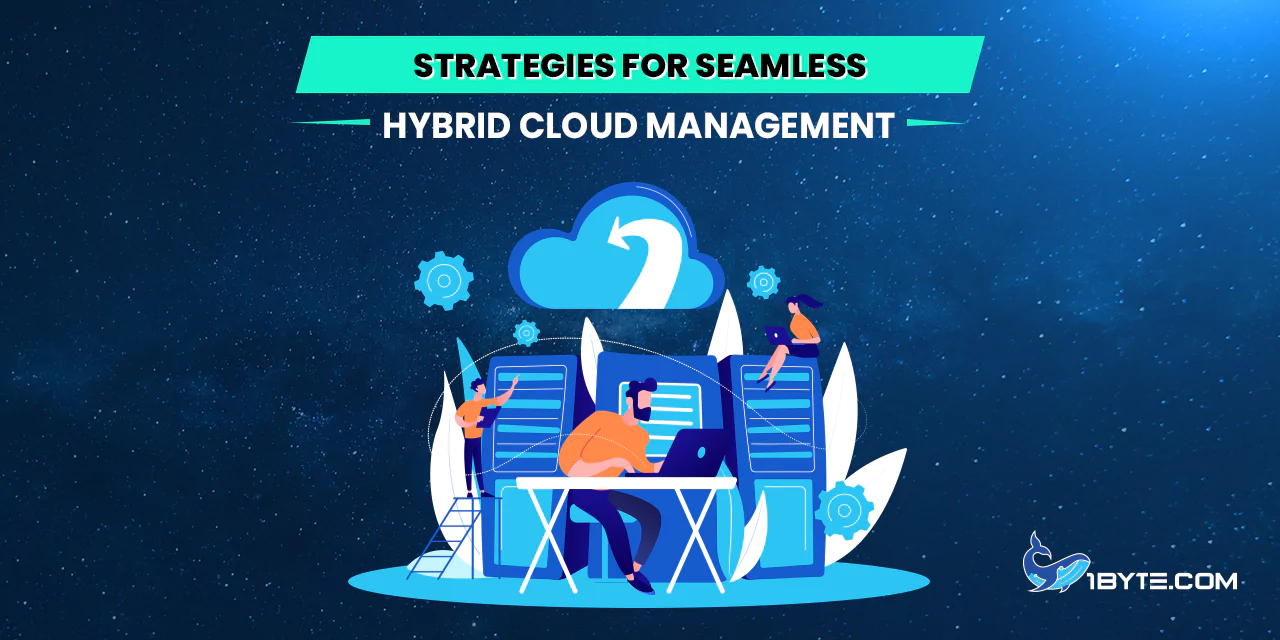In the world of modern IT infrastructure, the hybrid cloud has emerged as a pivotal solution, combining the benefits of both public and private clouds. Managing this hybrid environment efficiently is crucial for businesses seeking to harness its power. This article delves into effective strategies that make hybrid cloud management seamless and hassle-free.
With the rapid adoption of hybrid cloud among organizations, the need for adept management strategies becomes evident. Hybrid cloud management involves overseeing resources, applications, and data that span across both on-premises and cloud environments. This article explores how businesses can navigate the complexities of hybrid infrastructure while ensuring optimal performance and cost-efficiency.
Why is mastering hybrid cloud management so vital? Simply put, it enables organizations to leverage the flexibility of public clouds alongside the control of private clouds. By employing the right strategies, businesses can avoid pitfalls and complexities that often arise in such intricate setups. As the hybrid model gains momentum, the ability to seamlessly manage diverse components becomes a competitive advantage that organizations can’t afford to overlook.
This article outlines strategies that allow businesses to conquer the challenges of hybrid cloud management. From real-time monitoring to skill enhancement, these approaches ensure a smooth and effective operation of hybrid cloud environments. By implementing these strategies, businesses can maximize the potential of their hybrid setups while minimizing disruptions and bottlenecks.
Understanding Hybrid Cloud Management
In the realm of modern IT infrastructure, the concept of hybrid cloud management stands as a vital cornerstone.
Definition of hybrid cloud management
Hybrid cloud management, at its core, refers to the organized oversight of a company’s combined cloud and on-premises infrastructure. This entails coordinating and optimizing the operation of both public and private cloud resources in a way that seamlessly aligns with the organization’s objectives. In essence, hybrid cloud management is the art of harmonizing the strengths of various cloud models while mitigating their inherent complexities.
With hybrid cloud management, businesses exercise control over a hybrid environment that’s tailored to their unique needs. This involves determining where workloads and data should reside based on factors like security, compliance, and performance. By actively monitoring and governing these environments, organizations can ensure that resources are allocated optimally and are accessible whenever needed.
Hybrid cloud management isn’t just about overseeing the technical aspects; it’s about aligning technology with business goals. It enables organizations to adapt and scale their infrastructure seamlessly to meet changing demands. Through effective hybrid cloud management, companies can maintain a competitive edge, streamline operations, and embrace innovation with confidence. Ultimately, the mastery of hybrid cloud management empowers organizations to navigate the complexities of modern IT landscapes while achieving efficiency and agility.
Key challenges faced in managing hybrid environments
While hybrid cloud management offers a host of benefits, it also presents a set of unique challenges that organizations must navigate. These challenges stem from the complexity of coordinating resources and applications across various platforms. One of the primary hurdles lies in ensuring consistent performance and seamless connectivity between on-premises infrastructure and cloud services.
Security emerges as a critical concern in hybrid environments. Managing data protection across different domains while adhering to varying security protocols can be intricate. Ensuring compliance with industry regulations and standards becomes essential to safeguard sensitive information and maintain the organization’s reputation.
Another challenge relates to interoperability and integration. Integrating applications and workloads seamlessly between different cloud environments and legacy systems requires careful planning and execution. Resource allocation and optimization can also prove to be complex, as businesses need to strike a balance between cost-effectiveness and performance.

Operational complexity is a common hurdle, given the need to manage multiple management interfaces for different cloud services. This complexity can lead to inefficiencies and hinder the organization’s ability to respond swiftly to changing demands.
Furthermore, the shortage of skilled personnel who are well-versed in hybrid cloud management can pose difficulties. To tackle these challenges effectively, organizations must invest in training and skill development for their IT teams.
Navigating these challenges requires a holistic approach to hybrid cloud management. By addressing each concern strategically, businesses can ensure a seamless hybrid environment that maximizes benefits and minimizes disruptions. The following sections delve into strategies that help overcome these obstacles and create a harmonious hybrid cloud ecosystem.
Benefits of successful hybrid cloud management
Effective hybrid cloud management brings forth a myriad of advantages that empower organizations to thrive in the dynamic digital landscape. These benefits underscore the value of implementing strategies for seamless hybrid cloud management. Here’s how organizations stand to gain:
1. Improved Scalability
The ability to scale resources as needed is a cornerstone of hybrid cloud management. In a survey conducted in 2021, it was found that 58% of respondents recognized enhanced scalability as a primary benefit of leveraging hybrid and/or multicloud technology. This means businesses can effortlessly adapt to changing workloads and demands, optimizing resource allocation without over-provisioning.
2. Efficiency and Simplified Operations
Consistent cloud management contributes to streamlined operations and heightened efficiency. A study from 2019 revealed that 90% of respondents from organizations with uniform cloud management reported increased efficiency and simplified operations. This translates to reduced complexities in overseeing diverse cloud environments and on-premises infrastructure.
3. Customizability
The hybrid cloud environment offers a degree of customizability that aligns with an organization’s unique requirements. Over half of the respondents in 2021 acknowledged the customizability of hybrid and/or multicloud technology as a notable benefit. This empowers businesses to tailor their infrastructure to suit specific workloads, applications, and compliance needs.
4. Enhanced Collaboration
Cloud management consistency fosters collaboration between IT teams and line-of-business stakeholders. A significant 76% of respondents in a 2019 global survey believed that increased cloud management consistency would improve collaboration. This signifies a more cohesive environment where technology seamlessly supports business goals.
5. Accelerated Innovation
Cloud management’s impact on innovation is substantial. 74% of respondents in 2019 believed that enhanced cloud management would drive faster innovation within organizations. This translates to quicker development cycles and the ability to swiftly respond to market trends and customer demands.
Recommended reading: The Ultimate Guide to Cloud Scalability
Strategies for Seamless Hybrid Cloud Management
Navigating the intricate landscape of hybrid cloud management demands a well-thought-out approach that harmonizes diverse resources, technologies, and objectives. To harness the benefits and overcome the challenges posed by hybrid environments, organizations require strategies that ensure seamless operations. This section delves into a range of strategic approaches that empower businesses to master the art of hybrid cloud management while optimizing performance, scalability, and cost-effectiveness.
Comprehensive Resource Monitoring
Effective hybrid cloud management hinges on the ability to monitor resources comprehensively. Resource monitoring involves tracking the performance and utilization of various components within the hybrid cloud environment. This ensures that both on-premises and cloud-based resources are optimized for efficient operation.
Real-time Performance Tracking
Real-time monitoring tools provide immediate insights into the performance of hybrid cloud resources. These tools collect data on factors like CPU usage, memory consumption, and network bandwidth. By analyzing this data, administrators can quickly identify bottlenecks or issues affecting resource performance.
Proactive Issue Identification
Proactive monitoring allows administrators to detect issues before they escalate. When anomalies are detected, alerts are triggered, notifying the team about potential problems. This proactive approach prevents downtimes and enhances the overall stability of the hybrid cloud environment.

Capacity Planning and Scalability
Resource monitoring aids in capacity planning and scalability. By analyzing resource utilization trends, administrators can predict when additional resources will be needed. This prevents resource shortages and ensures smooth operation during periods of increased demand.
Cost Optimization
Monitoring also contributes to cost optimization. By tracking resource consumption, administrators can identify instances of over-provisioning or underutilization. This information helps in making informed decisions about resource allocation and can lead to significant cost savings.
Unified Monitoring Solutions
To simplify hybrid cloud management, organizations can adopt unified monitoring solutions. These tools provide a single interface to monitor both on-premises and cloud resources. This unified view streamlines management tasks and reduces complexity.
Security and Compliance Monitoring
Resource monitoring extends to security and compliance. Administrators can monitor access logs, detect unauthorized activities, and ensure compliance with industry regulations. This enhances the overall security posture of the hybrid cloud environment.
Automation and Orchestration
Streamlining hybrid cloud management involves leveraging automation and orchestration tools. These tools automate routine tasks and enable the coordination of complex workflows across both on-premises and cloud environments. This approach enhances efficiency and reduces the potential for errors.
Task Automation
Automation tools handle repetitive tasks, like provisioning virtual machines or scaling resources. By automating these tasks, administrators save time and reduce the risk of manual errors. This ensures that resources are allocated accurately and consistently.
Workflow Orchestration
Orchestration tools coordinate multi-step processes across hybrid environments. These tools ensure that tasks are executed in the correct sequence, even if they involve multiple platforms. This reduces human intervention and enhances the reliability of operations.
Hybrid Environment Management
Automation and orchestration help manage the hybrid cloud’s complexity. With tools that support both on-premises and cloud components, administrators can maintain consistency and control. This unified approach simplifies the management of diverse resources.
Rapid Scalability and Flexibility
Automated scaling allows resources to be adjusted quickly based on demand. This agility ensures that applications perform optimally, even during traffic spikes. The hybrid cloud’s scalability becomes a strategic advantage.
Policy Enforcement and Governance
Automation enforces consistent policies across the hybrid environment. This adherence to policies ensures security and compliance. Administrators can set rules that apply to both on-premises and cloud assets.
Efficient Resource Utilization
Orchestration optimizes resource utilization. It ensures that resources are allocated based on actual needs. This eliminates waste and promotes cost-effectiveness.
Continuous Monitoring and Adaptation
Automation tools often work with monitoring solutions to adapt to changing conditions. If performance thresholds are crossed, the system can automatically allocate more resources or take corrective actions.
Data Security and Compliance
When managing a hybrid cloud environment, ensuring data security and compliance is paramount. Hybrid cloud management involves handling sensitive data that moves between on-premises infrastructure and public or private cloud platforms. It’s important to implement robust security measures to safeguard this data.
Data Security
- Encryption: Use strong encryption methods to protect data both at rest and in transit. Encryption ensures that even if data is intercepted, it remains unreadable without the appropriate decryption keys.
- Access Control: Implement stringent access controls to restrict unauthorized access. Only authorized personnel should have access to sensitive resources, reducing the risk of data breaches.
- Multi-Factor Authentication (MFA): Require multiple forms of verification before granting access. This adds an extra layer of security, making it harder for unauthorized users to gain entry.
- Regular Auditing: Conduct frequent audits of your hybrid cloud environment to identify any security gaps or vulnerabilities. Address any issues promptly to maintain a secure environment.
- Patch Management: Keep all software, applications, and systems up to date with the latest security patches. Vulnerabilities in outdated software can be exploited by attackers.
- Intrusion Detection and Prevention: Deploy intrusion detection and prevention systems to monitor network traffic for any unusual or unauthorized activities. These systems can automatically block or alert administrators about potential threats.
Compliance
- Regulatory Requirements: Understand the industry-specific regulations and compliance standards that apply to your organization. Ensure that your hybrid cloud management practices align with these standards.
- Data Location: Be aware of where your data is stored and processed, especially if you’re dealing with sensitive customer information. Some regulations require data to stay within specific geographic boundaries.
- Data Governance: Establish clear data governance policies that outline how data is collected, stored, used, and disposed of. This helps maintain transparency and accountability.
- Regular Assessments: Conduct periodic assessments to verify compliance with relevant regulations. This involves evaluating your processes and procedures to ensure they align with the required standards.
- Data Retention Policies: Define how long data should be retained and when it should be securely deleted. This helps avoid unnecessary data storage and potential legal issues.
- Vendor Compliance: If you’re using third-party cloud providers, ensure they meet the necessary compliance standards as well. Review their security practices and agreements.
Scalability and Load Balancing
In the realm of hybrid cloud management, achieving smooth operations relies heavily on scalability and load balancing. These essential strategies pave the way for effective resource management and user experience enhancement.
Seamless Expansion
When it comes to handling varying workloads, scalability takes center stage. This dynamic approach ensures that the system can seamlessly expand or shrink as demands ebb and flow. By effortlessly adjusting its resources, hybrid cloud management maintains an optimal balance.
Efficient Workload Distribution
Load balancing complements scalability by evenly distributing tasks across available servers. This active distribution prevents any single server from becoming overwhelmed, keeping the workload manageable and responsive.
Strategic Task Allocation
Hybrid cloud management strategically allocates tasks based on server capacities. This strategic approach ensures that each task finds its ideal server, optimizing performance and responsiveness.
Adaptive Response
Hybrid cloud environments are subject to demand fluctuations. To tackle this, the management system adapts by redistributing workloads. This means that when demand spikes, the system intelligently shifts tasks to underutilized servers, preventing bottlenecks.
High Availability
Load balancing contributes to high availability. In the event of a server failure, tasks are promptly rerouted to other operational servers. This redundancy minimizes service downtime, aligning with the goal of seamless hybrid cloud management.

Efficiency and Cost-effectiveness
Scalability doesn’t just enhance performance; it also contributes to cost efficiency. Resources are allocated on-demand, eliminating the need for constant provisioning. Load balancing complements this by ensuring resources are used optimally, avoiding waste.
Intelligent Resource Management
Hybrid cloud management brings intelligence to resource allocation. It analyzes server performance and intelligently assigns tasks, ensuring that servers are utilized optimally, thus maximizing efficiency.
Elastic Performance
Scalability offers elasticity, allowing for quick performance adjustments. During traffic spikes, resources are added to cater to demand. As traffic subsides, the system scales down to maintain an efficient balance.
User-Centric Approach
Load balancing guarantees a seamless user experience. By evenly distributing tasks, users interact with efficiently allocated resources, ensuring a smooth journey through the hybrid cloud environment.
Real-time Monitoring and Adaptation
Hybrid cloud management monitors servers in real-time, tracking their workloads. This data-driven approach enables load balancing to adapt rapidly to changing conditions, maintaining optimal distribution.
FURTHER READING: |
1.Essential Tips for Effective Cloud Management |
2.What Is Virtualization and How Can It Benefit Your Business? |
3. Server Virtualization: Benefits and Best Practices |
Leverage 1Byte’s strong cloud computing expertise to boost your business in a big way
1Byte provides complete domain registration services that include dedicated support staff, educated customer care, reasonable costs, as well as a domain price search tool.
Elevate your online security with 1Byte's SSL Service. Unparalleled protection, seamless integration, and peace of mind for your digital journey.
No matter the cloud server package you pick, you can rely on 1Byte for dependability, privacy, security, and a stress-free experience that is essential for successful businesses.
Choosing us as your shared hosting provider allows you to get excellent value for your money while enjoying the same level of quality and functionality as more expensive options.
Through highly flexible programs, 1Byte's cutting-edge cloud hosting gives great solutions to small and medium-sized businesses faster, more securely, and at reduced costs.
Stay ahead of the competition with 1Byte's innovative WordPress hosting services. Our feature-rich plans and unmatched reliability ensure your website stands out and delivers an unforgettable user experience.
As an official AWS Partner, one of our primary responsibilities is to assist businesses in modernizing their operations and make the most of their journeys to the cloud with AWS.
Conclusion
As the digital realm continues to evolve, mastering hybrid cloud management becomes a strategic imperative. It enables enterprises to unlock unparalleled flexibility, robust performance, and an impeccable user experience. By leveraging the strategies outlined in this article, businesses can confidently navigate the intricacies of hybrid environments, propelling themselves towards sustainable growth and innovation.
In the grand tapestry of technology, where the lines between physical and virtual blur, hybrid cloud management stands as a guiding light, illuminating the path to a future where adaptability and efficiency reign supreme. Embrace these strategies, and embark on a journey towards seamless hybrid cloud management excellence.

